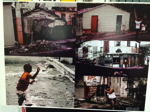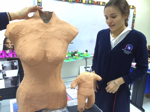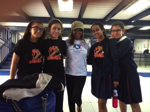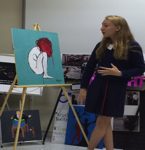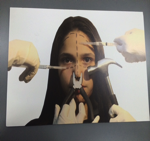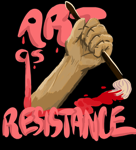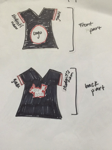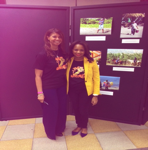Editor’s note: This blog is the second in a two-part series exploring how Pitts’ high school English students used art to take action against social injustices in their communities. Find the first part here.
After spending the previous few weeks analyzing social issues in the Dominican Republic (DR), my students brought in projects that expressed their resistance to issues like sexism, racism and poverty through the performing and visual arts. Projects ranged from body sculptures representing standards of beauty in the DR and Latin America to mini-films on common types of high school bullying. I was simply blown away.
Preparing for the Big Event
Although getting students to complete their projects (on time) was quite the challenge, their finished products were the motivation they needed to fully invest in the “Art as Resistance” event. They were very excited to showcase the projects they had worked so hard on!
Given the variety of projects that students came up with, we decided to structure the event in a way that would showcase each aspect. The first half of the event would be a visual arts exhibition in which audience members would walk around and discuss the pieces of artwork with the student artists. The second half of the event would feature the performing arts pieces: spoken word, monologues, skits, dances and short films and documentaries.
With this plan in mind, each student volunteered for one or two committees to carry out the tasks necessary to produce the event: advertisement, budget/fundraising, strategic planning, setup and food. The students were willing to meet after school to work and did incredibly well with their assigned “jobs”!
After discussing with students the relationship between equitable distribution of wealth and permanent social change, we agreed that the event should be a fundraiser. Students had studied the Universal Declaration of Human Rights in a separate lesson, and they agreed that an organization in the DR carrying out human rights work should receive the funds from the event. Upon receiving approval from the administration, the budget/fundraising committee identified worthy organizations and even schools, and students voted for the organization that would receive the funds.
The advertisement team decided to use different types of publicity: In addition to posters, flyers and handbills, the team also designed and created T-shirts that we would wear on the days leading up to the event. The principal and I both wore the shirts in solidarity. And finally, in order to ensure a big turnout, I offered extra points to students who invited more than three guests to the event.
The food committee worked alongside a few of the students’ parents to plan a beautiful and socially aware reception. With the budget/fundraising, publicity and food plans underway, we only had to rehearse and await the day of the event!
The Day of the Event
Although exhaustion had claimed my voice and the threat of rain nearly ruined the reception, the day of the event went great! Without being able to guide the students as I had hoped to, student leaders rose to the occasion and made the event a remarkable one. An earlier idea to have two administrative assistants and two student directors really came in handy.
The exhibition part of the event revealed striking artwork that advocated for LGBTQ rights and self-love, while other pieces addressed economic disparity and domestic violence. Photographs showed the effects of bullying and the impact of beauty standards on young girls in Latin America, and paintings of homeless men and children demanded that audience members react and respond.
Then the performing arts show began. As nearly 200 parents, siblings, teachers, other high school students, faculty and administrators took their seats, the 10th-grade MC gave them an important reminder: “It is important that we understand that this is not simply an event, something to come to, enjoy the show, and then return to our homes the same way we came,” he said. “It is important that we realize our power and the social responsibilities we carry not only for ourselves and the people in this room, but the responsibility to act on behalf of the countless others who live on this island.”
Students performed dances in which they used their bodies to express messages about standing up for others, and singers sang original melodies designed to foster critical thinking about how popular ideas in the media can cause individuals to doubt and question their beauty. Others delivered dramatic monologues that moved the audience to tears. One 10th-grader performed a particularly moving piece about the countless Dominican men whose livelihoods are dependent on their working in the streets, asking for money and washing the cars of those who can afford to drive them.
At the conclusion of the event, students had raised the equivalent of over $1,000 for a school in Azua, a poverty-stricken area about an hour outside of our school district in Santo Domingo that seeks to provide education, housing and food to orphans in the surrounding community.
Seeing the Impact
Students were on a high for weeks afterward, which is a big deal for high school students! They felt they had made a difference and were proud of their work. A few weeks after the event, I took a group of students to Azua to see the impact of their efforts. And while we all understood that our monetary, clothing and food donations would only do so much, we left Azua with a greater sense of our purpose and our responsibility to use the platforms that we have to make change. The students, particularly those who initially had felt powerless because of the vastness of the problems we explored, seemed to grasp the importance of the difference that one individual can make—on behalf of themselves and others—and that groups can make collectively.
My students continue to involve themselves in projects that positively impact their communities, and we continue to explore and discuss injustices and human rights violations. They understand that, while some people “don’t talk about this stuff,” they should—and they should act on it, too.
Note: You can find similar projects called “Do Something” tasks in Perspectives for a Diverse America for grades K-2, 3-5 and 6-12. (Free registration required.)
Pitts, a native of Columbus, Ohio, teaches ninth- and 10th-grade English literature at an international school in the Dominican Republic.
